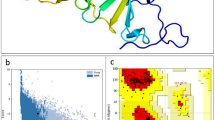Abstract
Pantoea agglomerans YS19 is a rice endophytic bacterium characterized to form multicellular biofilm-like structures called symplasmata. Phenotypic distinctions between symplasmata-forming cells and planktonic cells are crucial for understanding YS19’s survival strategies. In this study, a 43.1 kDa protein SPM43.1 was identified to show significant resistance to the aggregation effect caused by denaturing acidic conditions. MALDI-TOF analysis data indicated that it is a maltose-binding protein homolog while contains sequence homologous to the chaperone protein, ClpB. The purified SPM43.1 protein was detected to exhibit chaperone-like activities at acidic conditions, where its conformation transformed from an ordered to a globally less ordered structure as revealed by circular dichroism spectroscopy, showing a similar property to most chaperone proteins. The expression of SPM43.1 in YS19 is initiated when bacterial cells begin to aggregate, yet its amount in planktonic cells greatly exceeds that in symplasmata-forming cells, suggesting its crucial role to the survival of planktonic cells in experiencing environmental fluctuations. However, the bacterium prefers to form symplasmata, while not to express SPM43.1 proteins, for surviving the artificially set fluctuant (acid here) environments. This study provides valuable information on the life styles and survival strategies of microorganisms that forms multicellular aggregates at specific growth stages.






Similar content being viewed by others
References
Beloin C, Valle J, Lambert PL et al (2004) Global impact of mature biofilm lifestyle on Escherichia coli K-12 gene expression. Mol Microbiol 51:659–674
Boles BR, Thoendel M, Singh PK (2004) Self-generated diversity produces “insurance effects” in biofilm communities. Proc Natl Acad Sci USA 101:16630–16635
Bradford MM (1976) A dye binding assay for protein. Anal Biochem 72:248–254
Capestany CA, Tribble GD, Maeda K et al (2008) Role of the Clp system in stress tolerance, biofilm formation, and intracellular invasion in Porphyromonas gingivalis. J Bacteriol 190:1436–1446
Chen L, Sigler PB (1999) The crystal structure of a GroEL/peptide complex: plasticity as a basis for substrate diversity. Cell 99:757–768
Costerton JW, Lewandowski Z, Caldwell DE et al (1995) Microbial biofilm. Annu Rev Microbiol 49:711–745
Davey ME, O’Toole GA (2000) Microbial biofilms: from ecology to molecular genetics. Microbiol Mol Biol Rev 64:847–867
Duan JY, Shen DL, Feng YJ et al (2007) Rice endophyte Pantoea agglomerans YS19 forms multicellular symplasmata via cell aggregation. FEMS Microbiol Lett 270:220–226
Feng YJ, Shen DL, Song W et al (2003) In vitro symplasmata formation in the rice diazotrophic endophyte Pantoea agglomerans YS19. Plant Soil 25:5435–5444
Feng YJ, Shen DL, Song W (2006) Rice endophyte Pantoea agglomerans YS19 promotes host plant growth and affects allocations of host photosynthates. J Appl Microbiol 100:938–945
Fox JD, Kapust RB, Waugh DS (2001) Single amino acid substitutions on the surface of Escherichia coli maltose-binding protein can have a profound impact on the solubility of fusion proteins. Protein Sci 10:622–630
Gajiwala KS, Burley SK (2000) HDEA, a periplasmic protein that supports acid resistance in pathogenic enteric bacteria. J Mol Biol 295:605–612
Hong WZ, Jiao WW, Hu JC (2005) Periplasmic protein HdeA exhibits chaperone-like activity exclusively within stomach pH range by transforming into disordered conformation. J Biol Chem 280:27029–27034
Jeffery CJ (2003) Moonlighting proteins: old proteins learning new tricks. Trends Genet 19:415–417
Kapust RB, Waugh DS (1999) Escherichia coli maltose-binding protein is uncommonly effective at promoting the solubility of polypeptides to which it is fused. Protein Sci 8:1668–1674
Liu Y, Fu XM, Shen J et al (2004) Periplasmic proteins of Escherichia coli are highly resistant to aggregation: reappraisal for roles of molecular chaperones in periplasm. Biochem Biophys Res Commun 316:795–801
Miao YX, Zhang WB, Feng YJ (2009) Symplasmata formation in Pantoea agglomerans YS19 contributes to bacterial tolerance under detrimental conditions. J Microbiol 29:52–65 (in Chinese)
Richarme G, Caldas TD (1997) Chaperone properties of the bacterial periplasmic substrate binding proteins. J Biol Chem 272:15607–15612
Webb JS, Givskov M, Kjelleberg S (2003) Bacterial biofilms: prokaryotic adventures in multicellularity. Curr Opin Microbiol 6:578–585
Yang H, Sun X, Song W et al (1999) Screening, identification and distribution of endophytic associative diazotrophs isolated from rice plants. Acta Bot Sin 41:927–931
Acknowledgments
This study was supported by the National Natural Science Foundation of China (Nos. 31170035 and 30870055). The authors are grateful to Prof. Z. Chang (Peking University), and Prof. T. Han and Mr. C. Wu (Institute of Crop Sciences, Chinese Academy of Agricultural Sciences) for their constructive suggestions and to Mrs. P. Robb (School of Foreign Languages, Beijing Institute of Technology) for her assistance in proofreading.
Author information
Authors and Affiliations
Corresponding author
Additional information
Qianqian Li and Yuxuan Miao contributed equally to this article.
Rights and permissions
About this article
Cite this article
Li, Q., Miao, Y., Yi, T. et al. SPM43.1 Contributes to Acid-Resistance of Non-Symplasmata-Forming Cells in Pantoea agglomerans YS19. Curr Microbiol 64, 214–221 (2012). https://doi.org/10.1007/s00284-011-0055-6
Received:
Accepted:
Published:
Issue Date:
DOI: https://doi.org/10.1007/s00284-011-0055-6




